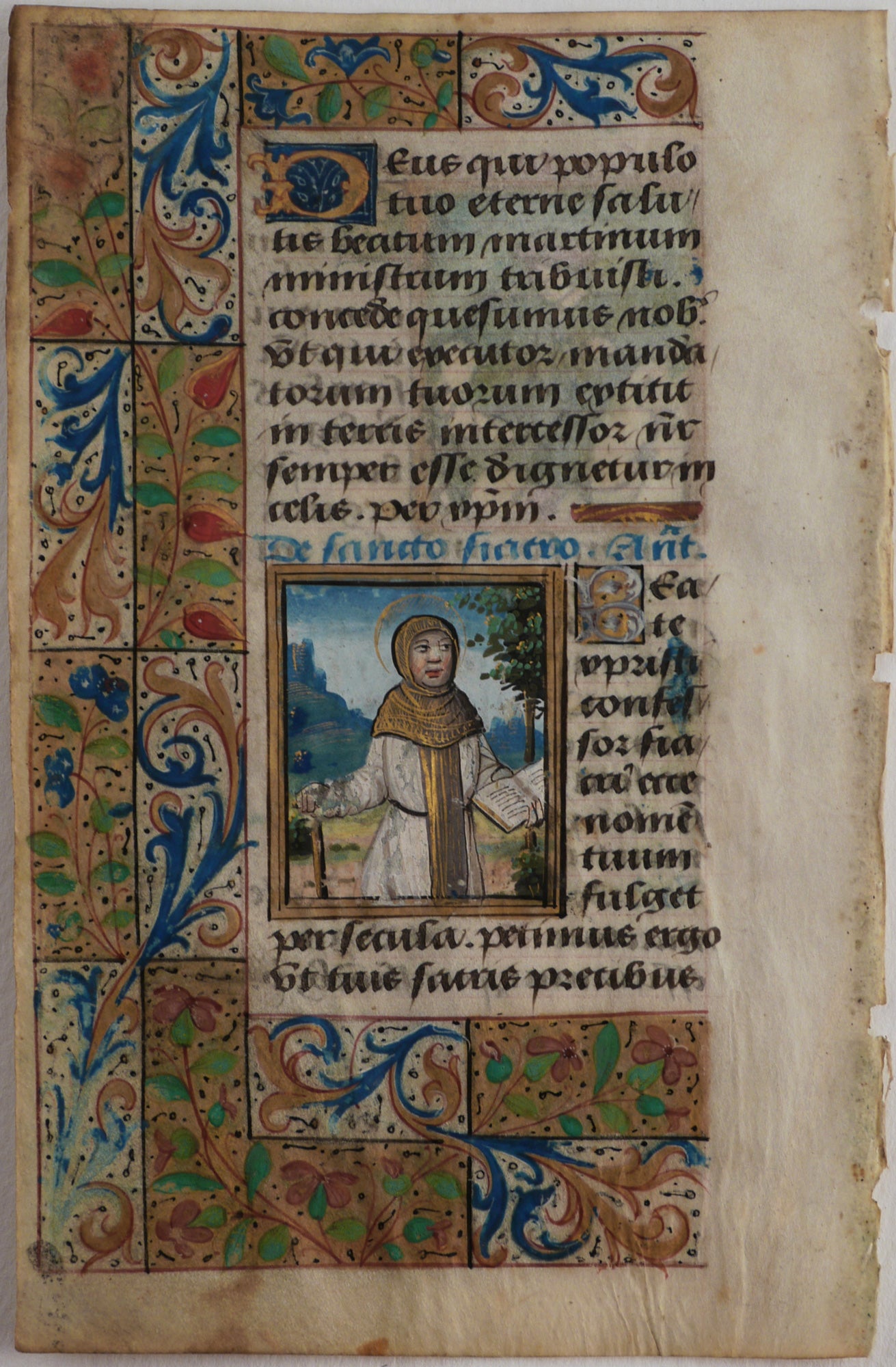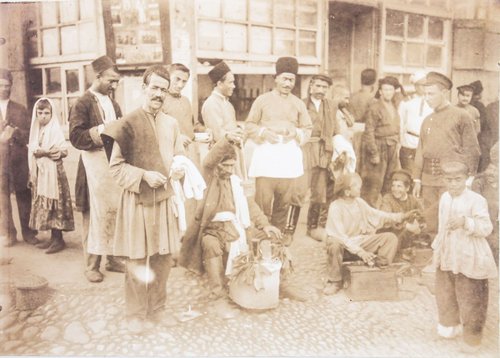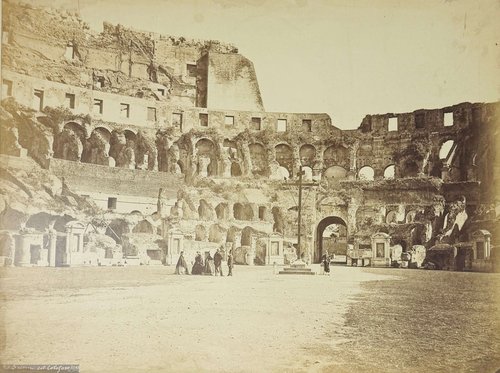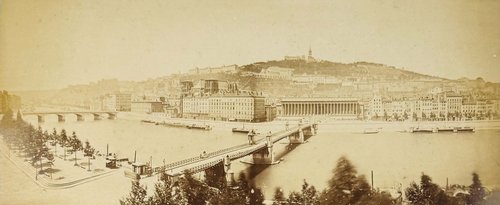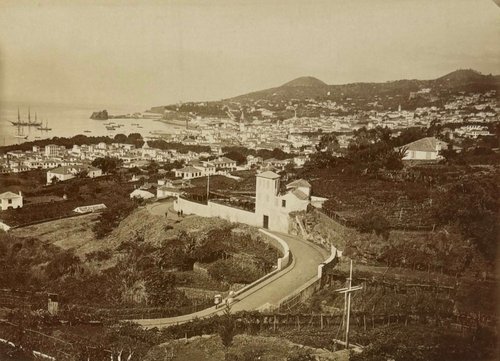
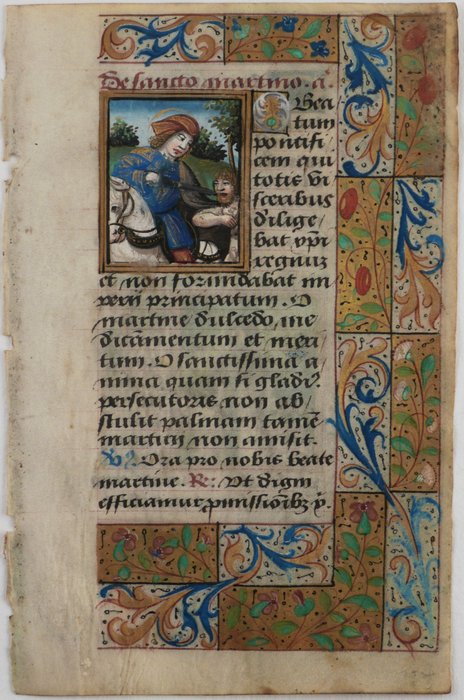
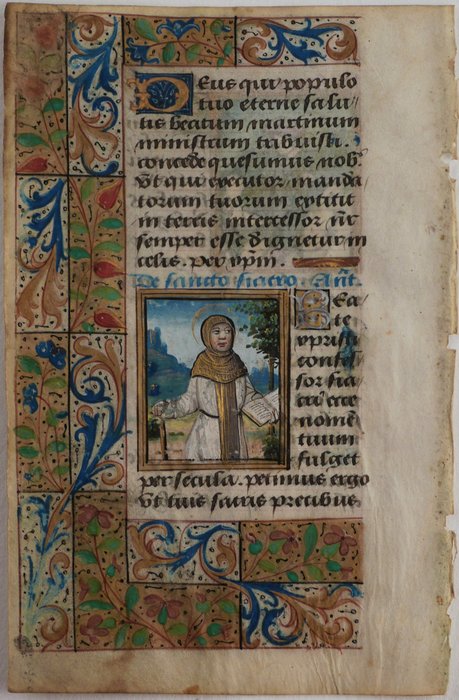
#MB20
Ca. 1510-1520
Single leaf, manuscript on vellum, written/decorated area ca. 14,8x8 cm (ca. 5 ¾ x 3 1/8 in); with two miniatures on recto and verso, each ca. 4,3x3,5 cm (1 5/8 x 1 3/8 in). Text in Latin. Both recto and verso with 22 lines. Text in brown, red and blue ink, recto with a two-line initial in white on gold background with a floral decoration, verso with two two-line initials in gold and white on blue and gold ground respectively; both recto and verso with elaborate ornamental borders decorated with flowers (illuminated in red, blue, green, and gold), both borders are from ca. 0,9 cm to ca. 3 cm wide (1/4 to 1 1/8 in). Very lightly toned, margin with very mild water stains on top and bottom outside corners, miniature portrait of St. Fiacre with a small pigment loss, but overall a very good leaf.
A beautiful illuminated manuscript leaf from the “Suffrages to Saints” part of a Book of Hours created in the studio of Jean Coene IV, a prominent French book artist of the early 16th century. The recto of the leaf contains the prayer to Saint Martin of Tours (316 or 366 - 397), one of the most familiar and recognizable French saints. The text of the prayer reads: “De sancto Martino. Ant: O beatum pontificem qui totis visceribus diligebat Christum regem et non formidabat imperii principatum. O Martine dulcedo medicamentum et meritum. O sanctissima anima quam si gladius persecutoris non abstulit: palmam tamen martyrii non amisit. V: Ora pro nobis beate Martine. R: Ut digni efficiamur promissionibus Christi. Deus qui populo tuo eterne salutis beatum Martinum ministrum tribuisti…” (Of Saint Martin, bishop. Ant: O blessed bishop who loved Christ the King with all thine inward parts and did not fear the sovereignty of the empire. O Martin, sweetness, medicine, and physician. O holiest soul, which if the sword of the persecutor had not taken away, nevertheless would not have lost the martyr's palm. V: Pray for us, most blessed Martin...). The miniature illustrates the famous story when Saint Martin cut his cloak in two to give a part to a beggar who wore rags in the middle of winter. Following the classical iconography of the event, St. Martin is shown mounted on a horse; he wears a blue robe and is cutting his grey cloak, covering a beggar at his left. The part of the cloak kept by St. Martin (cappa Sancti Martini) became a famous relic and brought to life such words as “cappellan” (French - chapelains, English - chaplain), a “priest in the military”; and “capella” (English - chapel), “a small church”.
The last twelve lines on verso start the prayer to Saint Fiacre of Breuil (d. 670) who built a hospice for travellers in what is now Saint-Fiacre, Seine-et-Marne in France: “De Sancto Fiacrio. Ant. Beate Christi confessor fiacri ecce nomen tuum fulget per secula petimus ergo ut tuis sacris precibus [adiuvemur a domino]”. The miniature depicts the saint in white monastic robe decorated in gold, with a Bible in one hand and a shovel in the other, referring to his love of garden work. St. Fiacre is known as the patron of gardeners and Parisian carriages which came to be known as fiacres.
“Jean Coene (also known as the Master of the Paris Entries), [was] a prolific artist who was active in Paris for the French court under Louis XII (1498-1515) and François Ier (1515-47). He was originally named after the manuscripts he painted recording the royal entries into Paris of Mary Tudor in 1514 (London, British Library, Cotton MS.Vespasian B II) and Claude de France in 1517 (Paris, BnF., fr.5750), until his name was discovered in the painted frame on a leaf with the Crucifixion from a Missal, inscribed with ‘De Jos Coene’ (Leuchtendes Mittelalter, Neue Folge 1, 1997, ill. On p.320). He collaborated regularly with the Pichore workshop who dominated Parisian book illumination in the first decades of the sixteenth century (C. Zöhl, Jean Pichore, 2004). Although his compositions and figures are related to those of Pichore, he is easily distinguishable by characteristic faces with swollen eyes, pronounced red lips and his generous use of gold highlighting. His quick painting technique and the careful finish of his miniatures led him to be one of the most successful artists for a high-ranking clientele in early sixteenth-century Paris” (Sotheby’s).


